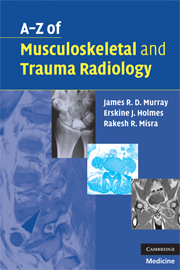Book contents
- Frontmatter
- Contents
- Acknowledgements
- Preface
- List of abbreviations
- Section I Musculoskeletal radiology
- Achilles tendonopathy/rupture
- Aneurysmal bone cysts
- Ankylosing spondylitis
- Avascular necrosis – osteonecrosis
- Femoral-head osteonecrosis
- Kienböck's disease
- Back pain – including spondylolisthesis/spondylolysis
- Bone cysts
- Bone infarcts (medullary)
- Charcot joint (neuropathic joint)
- Complex regional-pain syndrome
- Crystal deposition disorders
- Developmental dysplasia of the hip (DDH)
- Discitis and vertebral osteomyelitis
- Disc prolapse – PID – ‘slipped discs’ and sciatica
- Diffuse idiopathic skeletal hyperostosis (DISH)
- Dysplasia – developmental disorders
- Enthesopathy
- Gout
- Haemophilia
- Hyperparathyroidism
- Hypertrophic pulmonary osteoarthropathy
- Irritable hip/transient synovitis
- Juvenile idiopathic arthritis
- Langerhans-cell histiocytosis
- Lymphoma of bone
- Metastases to bone
- Multiple myeloma
- Myositis ossificans
- Non-accidental injury
- Osteoarthrosis – osteoarthritis
- Osteochondroses
- Osteomyelitis (acute)
- Osteoporosis
- Paget's disease
- Perthes disease
- Pigmented villonodular synovitis (PVNS)
- Psoriatic arthropathy
- Renal osteodystrophy (including osteomalacia)
- Rheumatoid arthritis
- Rickets
- Rotator-cuff disease
- Scoliosis
- Scheuermann's disease
- Septic arthritis – native and prosthetic joints
- Sickle-cell anaemia
- Slipped upper femoral epiphysis (SUFE)
- Tendinopathy – tendonitis
- Tuberculosis
- Tumours of bone (benign and malignant)
- Section II Trauma radiology
Non-accidental injury
from Section I - Musculoskeletal radiology
Published online by Cambridge University Press: 22 August 2009
- Frontmatter
- Contents
- Acknowledgements
- Preface
- List of abbreviations
- Section I Musculoskeletal radiology
- Achilles tendonopathy/rupture
- Aneurysmal bone cysts
- Ankylosing spondylitis
- Avascular necrosis – osteonecrosis
- Femoral-head osteonecrosis
- Kienböck's disease
- Back pain – including spondylolisthesis/spondylolysis
- Bone cysts
- Bone infarcts (medullary)
- Charcot joint (neuropathic joint)
- Complex regional-pain syndrome
- Crystal deposition disorders
- Developmental dysplasia of the hip (DDH)
- Discitis and vertebral osteomyelitis
- Disc prolapse – PID – ‘slipped discs’ and sciatica
- Diffuse idiopathic skeletal hyperostosis (DISH)
- Dysplasia – developmental disorders
- Enthesopathy
- Gout
- Haemophilia
- Hyperparathyroidism
- Hypertrophic pulmonary osteoarthropathy
- Irritable hip/transient synovitis
- Juvenile idiopathic arthritis
- Langerhans-cell histiocytosis
- Lymphoma of bone
- Metastases to bone
- Multiple myeloma
- Myositis ossificans
- Non-accidental injury
- Osteoarthrosis – osteoarthritis
- Osteochondroses
- Osteomyelitis (acute)
- Osteoporosis
- Paget's disease
- Perthes disease
- Pigmented villonodular synovitis (PVNS)
- Psoriatic arthropathy
- Renal osteodystrophy (including osteomalacia)
- Rheumatoid arthritis
- Rickets
- Rotator-cuff disease
- Scoliosis
- Scheuermann's disease
- Septic arthritis – native and prosthetic joints
- Sickle-cell anaemia
- Slipped upper femoral epiphysis (SUFE)
- Tendinopathy – tendonitis
- Tuberculosis
- Tumours of bone (benign and malignant)
- Section II Trauma radiology
Summary
Characteristics
True incidence unknown but increasingly recognised by health-care staff.
Classified into physical, sexual, psychological abuse and neglect.
Prevalent in all ethnic and socio-economic classes.
No sex preponderance seen in physical abuse.
Can occur at any age. Infants are more vulnerable to fatal head trauma than older age group.
Up to one-third of fractures in children may be non-accidental.
Clinical features
Spectrum of physical injuries from mild soft tissue to fatal trauma seen.
Usually present with an obvious injury but beware the non-specific presentation. Observe the child's behaviour and parental interaction.
History suggestive if injuries are not consistent with history; changing or incomplete history; delay in seeking help.
Beware the infant with head injuries or injuries suggestive of significant abdominal trauma.
Look for characteristic soft-tissue injuries such as circular burns (cigarette), linear weals, ‘finger-print’ bruises and immersion-burn injuries.
Accidental bruising is unusual in the non-ambulant child.
Radiological features
The location and developmental age of the child are better indicators than shape of long-bone fracture.
Metaphyseal fractures are characteristic but less commonly seen than shaft fractures (low specificity). Other highly specific fractures include scapular, posterior rib, spinal, sternal, multiple fracture of differing ages and complex skull fractures. Epiphyseal separations are suspicious.
Simple linear skull fractures can result from a minor accidental fall from height.
CT head may be required. Look for evidence of brain injury, associated haemorrhage or skull fracture.
Management
ABCs.
Sympathetic and considered approach to child and family.
Treat as you would for accidental injuries but consider all for admission.
Careful and accurate documentation. Photograph injuries if possible.
Involve experienced staff early if suspicious.
Follow local protocol (e.g. referral to paediatric registrar, check ‘At risk’ register, appropriate referral to social/community services).
- Type
- Chapter
- Information
- A-Z of Musculoskeletal and Trauma Radiology , pp. 92 - 95Publisher: Cambridge University PressPrint publication year: 2008



